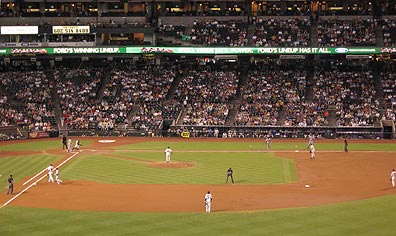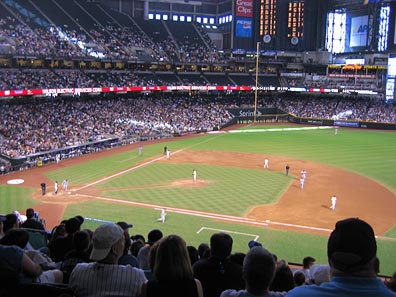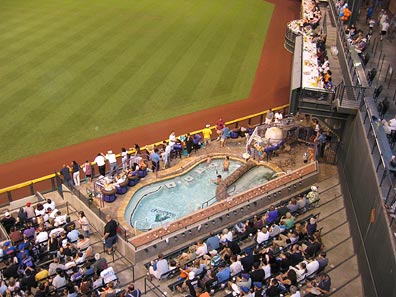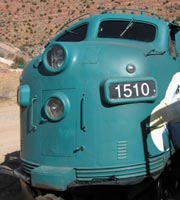Yet another expensive auto repair.
Our place at Howard Mesa Ranch is on top of the mesa, five miles from pavement.
When we bought our place from the original sales organization, the roads, although unpaved, were in pristine condition. I never saw a grader at work there, but the roads were always smooth and wide. Our sales guy, Larry, took us around in his old Buick sedan. That was six years ago.
Although Mike and I never expected the roads to be kept in that same great condition, we expected them to be kept in passable condition. Certainly by a Jeep or 4WD pickup truck — even while towing horses or a camping trailer. Hopefully by a sedan if driven carefully in dry conditions.
Flash forward several years. Road maintenance dollars, divvied out by the Property Owners’ Association, goes to the people who complain the most — who also happen to be the people who live closest to pavement. One of them whines that his road needs to be maintained so construction vehicles can reach his lot. One of those vehicles gets stuck and the POA pays to have it towed out. Dollars that should be spread around evenly on the roads that service all owners are laid on thick on the south end near Highway 64.
July 2004. I was living in a trailer on our Howard Mesa lot, working at Papillon at the Grand Canyon. I drove my Jeep down from the top of the mesa early in the morning to get to work by 7 AM. I hit a pothole in the road hard and instantly hear the sound of air hissing from the tire. I was still two miles from pavement and managed to get a mile closer before the tire was completely flat. Another property owner helped change the tire. The damaged tire could not be repaired. Replacement cost: $152.
August 2004. I’d flown to work that day in my old R22 helicopter, but storms in the area convinced me to leave the helicopter at the airport and drive home. My 1987 Toyota MR-2 was at the airport. I’d driven it on many occasions to and from our lot. But that day would be different. On that day, I’d get stuck in the mud two miles from my gate. I walked to my trailer in the drizzling rain, still in my uniform, as the sky darkened around me. A shortcut through a field got scary when I heard coyotes howling nearby and realized that I had nothing to protect myself from them. No damage to the car; just inconvenience. I came back two days later when the ground was dry and managed to make it the rest of the way to my lot.
October 2004. I take my Toyota to get an oil change. The quick lube place refuses to do the job. The oil pan is smashed in and they’re afraid they won’t get the plug back in after they remove it. The oil pan, which was obviously damaged while driving at Howard Mesa, has to be replaced — I don’t take the car off pavement anywhere else. Total cost $312.
May 2005. Mike and I bring our horse trailer with living quarters back up to our lot for the summer season. Erosion has narrowed the road in places. The 35-foot long trailer slips into a ditch on the driver’s side, smashing the valve for the black water holding tank. We get it back on the road. It then slips into a ditch on the passenger side, smashing the step to the trailer door. Total cost: $268.
May 2005. The next day. Mike and I take his truck on the other road that climbs up to our side of the mesa to see if it’s any better. It isn’t. It’s worse. The 4WD truck slides into a deep, mud-filled ditch. Another property owner tries to pull us out with his Jeep when our truck’s 4WD low setting doesn’t do the trick. The truck is stuck fast in the muck. AAA refuses to send someone to tow us out. We pay a local tow company to do the job. Total cost $250.
We make a lot of noise at the POA annual meeting. It wakes up the POA decision makers. They finally start spending some money on road maintenance on our part of the “ranch.” They grade the state road and spread cinders in the most slippery spots. They put in culverts. But the money runs out before the job can be finished. The road is much better, but has a few very tough spots to negotiate, spots where tire placement can mean the difference between clearing the ground and bottoming out. Yet last week the cinder truck spread cinders on a perfectly smooth road that is never even used. Could it be because there are two lots are for sale on it and the owners wanted the road to look “maintained”? That road is only about a mile from pavement.
July 2006. Today. MIke has driven up for the weekend in his Honda Accord. He’s driven very slowly, very carefully. But he still bottoms out once on his way down this morning. The oil trail starts about a mile short of pavement. His car’s oil light went on three miles south of the Howard Mesa turnoff on Route 64. The oil pan is so torn up that Mike can stick his finger in it. Total cost: unknown so far. But the tow to Williams was $89, the rental trailer to bring the car from Williams to a Honda dealer in Flagstaff was $64, the rental car so he could get to work tomorrow was $86. He missed work today. The cost of the oil pan and replacement labor will probably exceed $300.
[August 1 Update: The Honda’s engine damage was severe and the engine needed to be replaced. Thank heaven it was covered by insurance. It would have cost thousands of dollars.]
It struck me today that we spend more on repairs to our vehicles due to road conditions than we do on property taxes, POA dues, and even hauled water combined. What’s wrong with this picture?
There are a lot of lots for sale at Howard Mesa Ranch. If you’re thinking of buying one, be sure you talk to the POA about maintenance on the road to your lot first.
Then, if you do buy, go out and get a high clearance 4WD vehicle. You’ll need it.
[composed on top of a mesa in the middle of nowhere with ecto]

 Mike had paid $52 apiece for the seats. I thought that was a little high. But it appeared that it was some kind of special concierge seating that included waitress service. (Huh?) It also included admission to the Acura Club, on our level in the outfield. Since we got there before the game started, we decided to check it out.
Mike had paid $52 apiece for the seats. I thought that was a little high. But it appeared that it was some kind of special concierge seating that included waitress service. (Huh?) It also included admission to the Acura Club, on our level in the outfield. Since we got there before the game started, we decided to check it out. The game started and we watched it while sipping iced tea and waiting for dessert. The Met started the inning and they promptly scored 3 runs. The Diamondbacks stepped up to the plate and stepped away scoreless.
The game started and we watched it while sipping iced tea and waiting for dessert. The Met started the inning and they promptly scored 3 runs. The Diamondbacks stepped up to the plate and stepped away scoreless. We left the Acura Club and went to our seats. The sound was much louder there, but the view was better, being so much closer to the action. There was a surprising number of Met fans in the audience, some of them even wearing Mets jerseys and hats. So when the Mets scored 6 more runs a bit later in the game, there was quite a bit of cheering. I really felt sorry for the D’backs at that point. They were losing 10 to 0.
We left the Acura Club and went to our seats. The sound was much louder there, but the view was better, being so much closer to the action. There was a surprising number of Met fans in the audience, some of them even wearing Mets jerseys and hats. So when the Mets scored 6 more runs a bit later in the game, there was quite a bit of cheering. I really felt sorry for the D’backs at that point. They were losing 10 to 0. There was a faint glimmer of hope a bit later in the game when one of the Diamondbacks hit a home run. It went over the right field wall into the swimming pool area. Yes, I did say swimming pool. One of the oddities of Chase Field is the swimming pool just outside of right field. It appears that you can rent it for parties and the like during the game. I took this photo from the Acura Club; you get the idea.
There was a faint glimmer of hope a bit later in the game when one of the Diamondbacks hit a home run. It went over the right field wall into the swimming pool area. Yes, I did say swimming pool. One of the oddities of Chase Field is the swimming pool just outside of right field. It appears that you can rent it for parties and the like during the game. I took this photo from the Acura Club; you get the idea. I couldn’t remember where this photo was taken, either. I knew it was in Maine and I knew I’d taken it on one of our outings with John and Lorna. So I e-mailed Lorna a copy of the image and asked her. The response came back almost immediately: Samoset Resort in Rockland, ME.
I couldn’t remember where this photo was taken, either. I knew it was in Maine and I knew I’d taken it on one of our outings with John and Lorna. So I e-mailed Lorna a copy of the image and asked her. The response came back almost immediately: Samoset Resort in Rockland, ME. You also can’t see the building at the end of breakwater about a mile from where this photo was taken. Here it is. It was a lighthouse and apparently still functions as one. But it’s closed to the public, so you can just walk around it or onto its stone steps. We spent some time sitting out in the sun, watching the boats go by. It was a peaceful, relaxing place. There was some fog in the trees on the other side of the channel — the same fog we’d walked through earlier in the day when visiting the Owl’s Head Lighthouse. (Did I get that one right, Lorna?)
You also can’t see the building at the end of breakwater about a mile from where this photo was taken. Here it is. It was a lighthouse and apparently still functions as one. But it’s closed to the public, so you can just walk around it or onto its stone steps. We spent some time sitting out in the sun, watching the boats go by. It was a peaceful, relaxing place. There was some fog in the trees on the other side of the channel — the same fog we’d walked through earlier in the day when visiting the Owl’s Head Lighthouse. (Did I get that one right, Lorna?) I took this photo of John and Lorna on the way back to the car. John’s not an easy guy to get a picture of. It seem like every time you tell him to stand still and pose for a picture, he acts like he doesn’t believe someone’s really going to take his picture. So you have to take a few of them in a row for one of them to come out natural enough to use. This one gets them both.
I took this photo of John and Lorna on the way back to the car. John’s not an easy guy to get a picture of. It seem like every time you tell him to stand still and pose for a picture, he acts like he doesn’t believe someone’s really going to take his picture. So you have to take a few of them in a row for one of them to come out natural enough to use. This one gets them both. The ride ends at Perkinsville, where the canyon opens up to a broader valley. There’s a ranch there and the train stops literally in front of the ranch house. The place appeared occupied — there were horses and cattle there — but there wasn’t a person in sight. The conductor guy told us the story. Years and years ago, when the railroad was built, the land at the ranch was needed as a station to take on water and fuel for the steam engines. The railroad had offered the land owners a lump sum or a royalty for the use of the land. The Perkins family had taken the lump sum, giving up their control of the right of way. Today, under new ownership, the tour train had control of the land. The people who live in the house make themselves scarce when the train stops there on every run.
The ride ends at Perkinsville, where the canyon opens up to a broader valley. There’s a ranch there and the train stops literally in front of the ranch house. The place appeared occupied — there were horses and cattle there — but there wasn’t a person in sight. The conductor guy told us the story. Years and years ago, when the railroad was built, the land at the ranch was needed as a station to take on water and fuel for the steam engines. The railroad had offered the land owners a lump sum or a royalty for the use of the land. The Perkins family had taken the lump sum, giving up their control of the right of way. Today, under new ownership, the tour train had control of the land. The people who live in the house make themselves scarce when the train stops there on every run. Why does the train stop at all? Well, this is the place the engines are moved from the front of the train to the back for the return ride. There’s a siding there and while we’re waiting, enjoying the scenery and feeling kind of bad for the people who have to deal with 130 tourists a day looking into their windows, the engineer takes the two engines and moves them. The task takes about 20 minutes and they sell ice cream sandwiches to us while we wait. Then we’re on our way back to Clarkdale at a slightly faster speed, leaving Perkinsville behind.
Why does the train stop at all? Well, this is the place the engines are moved from the front of the train to the back for the return ride. There’s a siding there and while we’re waiting, enjoying the scenery and feeling kind of bad for the people who have to deal with 130 tourists a day looking into their windows, the engineer takes the two engines and moves them. The task takes about 20 minutes and they sell ice cream sandwiches to us while we wait. Then we’re on our way back to Clarkdale at a slightly faster speed, leaving Perkinsville behind.